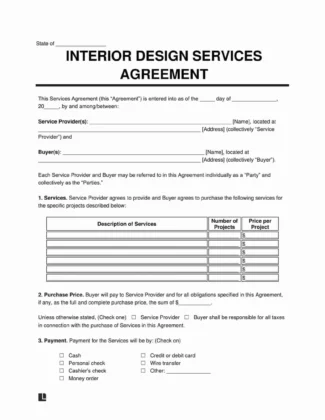
If you’re carrying out interior design work for a client, use a template to outline what work will be carried out.

Updated May 22, 2024
Written by Sara Hostelley | Reviewed by Brooke Davis
An interior design contract lets you establish clear expectations and financial terms for an interior design project. Whether you’re the designer or the client, you can streamline management and provide legal protection for everyone involved.
An interior design contract is a service agreement between the designer and the client. It includes a detailed list of the scope of the work, party information, and other critical parts of an enforceable contract.
Interior design contracts outline what types of work will be done in the home, business, or another area that needs to be designed. It might include a list of the services and materials necessary to perform the work.
Outline the scope of the project in as much detail as possible. Everything that you intend to charge for needs to be mentioned. You also need to detail what your work does not include: any services that will need to be provided by contractors, such as plumbing, electrical, and ventilation.
You must decide how to charge your clients, such as hourly or fixed fees. If you charge hourly, include your rate, and all time spent on the project, including responding to emails, researching, drawing, and purchasing products, will be charged.
You could also include that the fees will be charged in increments and can be paid when they receive an invoice.
You need to include in the contract a section about your drawings. You need to state that any drawings, plans, or renderings are conceptual and are intended to set forth design intent.
Also, you need to emphasize that your drawings rely on the accuracy of the information provided by your client and that, unless you’re measuring yourself, you won’t be liable for any miscalculations or design flaws.
If necessary, you can state that your designs are purely for the contracted project and cannot be shared or used for other purposes.
If you’re purchasing furnishing items or ordering anything for the project, you need to detail that these won’t be refundable, especially for custom-made orders.
You may also want to include a section covering expenses the client must reimburse, such as travel costs or storage fees.
Clearly state the timeframe you must be paid and the payment terms. If you send invoices to the client, include when you will send them and how long they have to pay after receiving one.
Interior design fees can vary depending on experience, location, and project size. Here’s the information on interior design pricing structures:
A few tips specific to interior design contracts you should consider include:
No-Price Guarantee Clause (Limited)
You can include a “No-Price Guarantee” clause to assure clients that your initial consultations or project assessments are provided without any upfront cost.
Detailing Separate or Optional Design Fees
Detail any design fees that are separate or optional within the project scope. Offer a separate price list for optional services not included in the base package
Addressing Changes Mid-Project
Outline a clear roadmap for handling changes in the middle of the design process. Specify limitations on change requests.